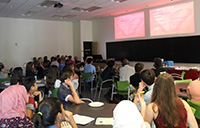For the first time, the Biophysics program in the Department of Physics & Astronomy, Faculty of Science, hosted an Ontario-wide Biophysics Contest for high school students. More than 160 students participated, and the top contestants received their prizes at a dinner ceremony at York at the end of June.
 The contest called for teams of up to three students in Grades 9 to 10 or 11 to 12 to create and submit a narrated slide presentation on a topic in biophysics.
The contest called for teams of up to three students in Grades 9 to 10 or 11 to 12 to create and submit a narrated slide presentation on a topic in biophysics.
A list of more than 20 topics to choose from was provided, including questions like: How is radioactivity used to diagnose illness? How do soil nutrients get to the top of a tree? How can we build computers out of DNA?
The winners were selected by a panel of students and faculty at York University, and received generous cash prizes.
“Our goals were to inform and excite students about biophysics, an exploding frontier of science,” explains Marshall McCall, chair of the Department of Physics & Astronomy. “We feel that if high school students become more acquainted with the field, they will be more likely to consider studying it in university.”
The dinner ceremony was attended by nearly 50 students, teachers and guests. Chris Bergevin, professor in the Department of Physics & Astronomy, delivered a keynote address about the biophysics of hearing, after which the awards were presented and the first-place submissions showcased.
The first prize for students in Grades 9 to 10 went to a team from Danforth Collegiate and Technical Institute for their presentation “Antimatter: The Cure for Cancer.” The top prize for Grades 11 to 12 went to a team from Bayview Secondary School for their presentation “How Does a Butterfly Wing Get its Colours?”.
Many of the students expressed positive impressions about the contest, feedback that the event was a fund and unique experience. Both students and teachers mentioned that they look forward to next year’s biophysics contest.
Following the ceremony, guests were taken on a tour of several research laboratories on campus, including the Undergraduate Biophysics Laboratory and the Observatory, with many choosing to stay afterwards for the Observatory’s public viewing program.


